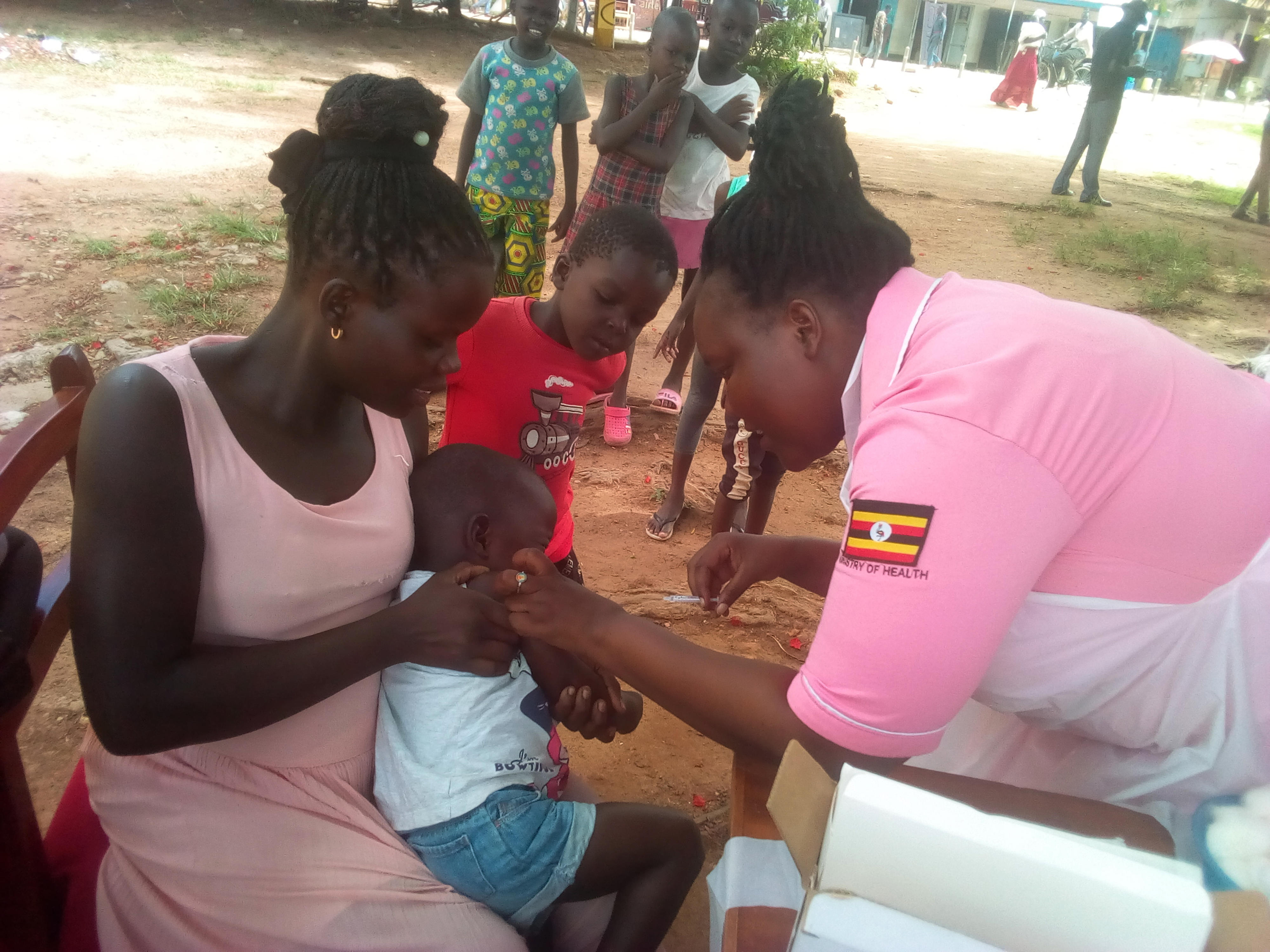Prime
How population growth hampers health service delivery

A health worker immunises a child at Soroti City Police Barracks Health Centre last year. PHOTO | FILE
What you need to know:
- Uganda is a signatory to several international conventions that uphold health rights and the right to health, which include the Universal Sustainable Development Goal (SDG) Three, which aims to reduce by one-third premature mortality from non-communicable diseases through prevention and treatment and to promote mental health and wellbeing by 2020. However, as Gillian Nantume writes, the population size and growth rate can affect the long-term health agenda of the country.
A healthy population greatly contributes to a country’s development. Healthy people are more likely to live a long and fulfilled life, are more educated, and are more productive. They will have more earnings, and more savings and will, in turn, invest more in the economy.
The size of a population is a key determinant of the number of health facilities and workers needed to deliver quality health care. With a population of 45.9 million people and an annual population growth rate of 2.9 percent, Uganda has 155,000 health workers but needs 187,000 more.
However, the Director of Clinical Services at the Ministry of Health (MoH), Dr Charles Olaro, says the current health policy is viable and should ably meet the needs of the growing population.
“Our national health system is pluralistic, with both public and private facilities. Currently, there is a Health Centre III for every 20,000 people, and we are providing two community health workers and a village health team in every village. Those who have money can seek care in private facilities,” he says.
How efficient is the health system?
According to the 2023 Harmonised Health Facility Assessment in Uganda report, the number of health facilities (public, private and private not-for-profit) now totals 6,937, out of which, 3,133 are government-owned.
The country boasts four national referral hospitals and five specialised hospitals, which include Mulago Super Specialised Hospital, Mulago Women and Neonatal Specialised Hospital, Regional Paediatric Surgical Hospital, Entebbe, Uganda Heart Institute, and Uganda Cancer Institute. There are 17 regional referral hospitals and 62 general hospitals.
In Yumbe District, though, Zubair Ojjo, the acting district health officer says, the healthcare system is a long way from operating efficiently. With a population of 972,351, up from 484,822, the district is the third most populous in the country.
“Right from 2014, we have been serving an ever-increasing population in only 25 health facilities. These facilities, when compared to the population size, are not enough. Some sub-counties do not have health units. We have facilities delivering only outpatient services because they cannot support an inpatient department,” he says.
Eng George Otim, the Commissioner of Health Infrastructure in the MoH, refutes this saying the country is not in a crisis of health facilities.
“In the last five years, we have added 413 beds in health centre IIIs across the country. That translates to 8,026 beds. Some health centre IVs in districts such as Sembabule and Bugweri do not have patients. For instance, Busesa Health Centre IV has many beds but only expecting mothers who go there to deliver. So, we can handle this population, unless an epidemic occurs,” he says.
Dr Olaro adds that the concern should not be about the number of health facilities, but about how efficiently the health system is running.
“We want fewer people to attend our health facilities. We are encouraging prevention (of sickness). But, if a health centre has a maternity ward, an outpatient department, an inpatient department, a laboratory, and a good referral system, this should be enough,” he says.
Stressed infrastructure
Public health sectors in the least developed nations are often overburdened and unable to deliver optimal care. Although the 2023 Harmonised Health Facility Assessment in Uganda report indicates that the country has 30,242 inpatient beds, of which 6,999 are dedicated maternity beds, Eng Otim refutes these statistics.
“We have about 2,000 health centre IIIs, and each is supposed to have 20 beds. Those are 40,000 beds. During Covid-19, I procured 16,000 beds to add to the old stock. That means the country has about 60,000 beds, which I believe, are adequate for this population,” he says.
Uganda is a young country, whose makeup is 50.5 percent children (0-17 years), 22.7 percent youths (18-30 years), five percent older persons (60+) and 55.6 percent working age population (14-64 years).
However, the MoH report indicates that adolescent health services are available in less than half (48 percent) of the health facilities countrywide. Basic emergency obstetric and newborn care is available in 48 percent of facilities, while post-abortion care is offered at 47 percent of facilities countrywide.
The report also showed extremely low basic water, sanitation, and waste management services based on the Joint Monitoring Programme indicators. Lango region had the lowest water and hygiene services (31 percent) available.
Basic equipment in the main service areas, such as, thermometers, stethoscopes, blood pressure machines, and adult weighing scales were available at all levels of care ranging between 76 percent and 81 percent.
“The quantity of (medical) supplies that the National Medical Stores delivers may be fairly okay, but with the number of patients and diseases increasing, essential medicines are not enough. This is compounded by community attitudes towards healthcare, which are very poor. They do not take responsibility for their health and this puts a lot of pressure on our services,” Mr Ojjo laments.
Essential medicines, as defined by the World Health Organisation (WHO) are available in less than half of the facilities (49 percent). Availability of essential drugs such as Beclomethasone (four percent), Simvastatin (seven percent) ARV first-line combination treatment regimen (19 percent) and ready-to-use therapeutic food (11percent) is low.
However, readily available medicines include Paracetamol tablets (88 percent) Amoxicillin tablets (95 percent), Artemisinin-based combination therapy (93 percent) oral rehydration salts (91 percent), Zinc sulfate tablets (90 percent), hormonal contraceptives (83 percent) and folic acid (94 percent).
Number of health workers
In an article carried by Sunday Monitor last week, donors and health experts expressed concern over the chronic understaffing of the health sector, a challenge that they claimed continues to deny Ugandans access to quality and timely healthcare services.
This was during a national policy dialogue of the health workforce in Uganda, organised by WHO. It was noted that Uganda needs 342,832 health workers, but has only 155,000.
The Analysis of the Health Labour Market report indicated that currently, there are 7,793 medical doctors and specialists. This translates into one doctor per 5,902 people. The nursing professionals, both in the public and private sector are 73,956, midwifery professionals are 32,959, dental surgeons are 504, and pharmacists are 1,712.
“The ministry has reviewed the existing structures of health centre IIIs and IVs. The government and the Ministry of Public Service are aware of the review and once it is approved, health centre IVs will be upgraded to community hospitals, which are projected to serve a population of 100,000. The community hospitals will have five doctors and 12 nurses and general staff will be increased from 48 to 152,” Dr Olaro says
However, upgrading health centres when there is still a cap on recruitment will barely meet the staffing needs of the healthcare system. At the WHO dialogue, the Minister of Health, Dr Jane Ruth Aceng, said training, recruitment and retaining of human resources for health, is an emergency that the ministries of Finance, Planning and Economic Development and Public Service must embrace.
“When you want to recruit, you need clearance from public service (ministry), which may take eight months, and when you delay recruiting, the permanent secretary gets a letter asking her to return the money, you request for theatre cadres, but you are only given an anaesthetic officer without a theatre nurse. Do these people understand that some of the health cadres work as a team?” she is quoted as asking.
She added that of the 1,500 health professionals churned out of training institutions annually, very few are recruited into the health system and hence the challenge continues.
“The numbers are our next point of action,” Dr Olaro says, adding, “We are producing health workers (from universities and tertiary institutions) but they need to be recruited and retained to offer services to the population. We need resources to get those people in place. If this is done, it will reduce the burnout of health workers who are currently employed by the government.”
The health budget for the 2024/2025 Financial Year is Shs2.946 trillion. However, this budget does not cater for the new staffing structure at health facilities.
“That is now the paradox. The health budget has been increasing and progressing, but not in proportion to the growing population. So, it will bring a few challenges in terms of long-term planning. However, we are optimistic that our plans of upgrading Health Centre IVs and recruiting more health staff will come to fruition. The structures are not supposed to be filled in one year. The last time we restructured was 20 years ago, so we have the next 20 years to get it right. It is important that, at least, we should have some recruitment process going on every year,” Dr Olaro says.
Using the mantra of ‘Health is Wealth,’ Dr Olaro calls on the government to increase investment in the healthcare system.
“If people are healthy, they will participate in economic activities that will develop the country, after all, most people spend their money on ill health. So, investing in health is the right investment. The good thing is that the private health sector has also grown, offering services to those who can pay. Our oversight role as a ministry is to ensure the quality of services is good and that the patients are safe,” he says.
However, besides the availability of health workers, their performance levels are also key to evaluating whether they are serving the population.
Building a resilient system
Statistics show that younger people are more at risk of contracting communicable diseases, while the elderly are more at risk of non-communicable diseases. The middle-aged are more at risk of injuries. The population structure often has a major effect on the future of illness, which means the government has to take into account the frequency of communicable diseases.
According to the 2023 Harmonised Health Facility Assessment in Uganda report service availability for communicable diseases, especially malaria services, HIV and STI services, was high in the country and across regions. However, Kampala had the least availability of tuberculosis services while Ankole region had low availability of HIV services.
Availability of non-communicable disease services (Diabetes, CVDs, CRDs) was moderately low across the country while service availability for cancers and palliative care was extremely low. These services were least available in government-owned facilities, and lower in rural areas compared to urban settings.
If every Ugandan is to access the same level of healthcare regardless of where they live, adapting to the growing population, having a robust crisis response and providing quality routine healthcare is a core function. Eng. Otim says the first step towards this goal is strengthening primary healthcare.
“We are not going to admit all of you to the health facilities. Most of our sicknesses are manageable up to 80 per cent through proper sanitation. You do not know how many infections you can prevent just by washing your hands and having proper toilet facilities. In recent days, we are promoting primary health care, including strengthening our sanitation component,” he says.
Eng Otim adds that the second step is to have robust emergency medical services for those who need referrals.
“We are ensuring that health centres and general hospitals have the required equipment. We have procured CT scans for regional referral hospitals and ensured that they have high-level intensive care units. We are installing X-ray machines in all hospitals and we have just procured an oxygen plant, which we expect to generate 5,000 cylinders of oxygen. This should be enough for the country even with an outbreak of an epidemic,” he says.
He argues that with the referral system in place and working, 80 percent of the population can be treated at the Health Centre III level, with few special cases referred for higher-level treatment. At that point, there will be no pressure on service provision.
According to the World Population Prospects: The 2017 Revision, published by the United Nation’s Department of Economic and Social Affairs, “From 2017 to 2050, it is expected that half of the world’s population growth will be concentrated in just nine countries; India, Nigeria, the Democratic Republic of the Congo, Pakistan, Ethiopia, the United Republic of Tanzania, the United States of America, Uganda and Indonesia.”
Today, Uganda has an annual population growth rate of 2.9 percent, down from three percent. The management of our population growth must be given higher priority by the government if the country is to have a healthy population that can implement the National Development Plan IV.
According to the United Nations, the fastest growing populations are in the least developed countries, where entire communities will never have the opportunity to live a life of the same rights and choices as other people in developed countries.
Produced by Nation Media Group in partnership with The Bill and Melinda Gates Foundation.





